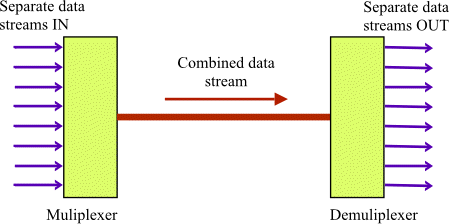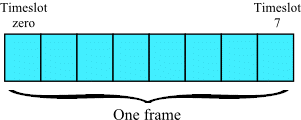TDM
Stands for: Time Division Multiplexed
This is one method by which multiple streams of data are combined together into a single stream of data for transmission down a cable or optical fibre. The combined streams may then be separated out again into individual streams at the far end of the cable as required.
 |
||
When digital data are merged using time division multiplexing, the resulting merged data stream is structured as a series of small blocks, called timeslots, within a series of larger blocks called frames.
 |
||
Each timeslot contains a fragmented sample from one of the input data streams and one frame carries the complete group of timeslots representing all the input channels. The structure of a frame is fixed and it is of a fixed length, so the required bandwidth for transmission of TDM data can be calculated in advance and does not vary even if some of the input streams are idle or have no signal. One timeslot is normally assigned to carry one channel of data, but it may also be reserved for synchronisation to make it easier for the receiving equipment to recognise where each frame starts and ends. At the receiving end, the data within the timeslots is extracted and the original individual signals can be reconstructed.
The use of TDM inevitably introduces a slight time delay because of the way the data have to be chopped up and re-assembled. In telephony circuits TDM is very widely used for the transmission of multiple individual telephone conversations down a single cable or optical fibre.